The Motorola Atrix 4G Preview
by Anand Lal Shimpi on February 13, 2011 3:18 AM ESTA couple of months ago I had the opportunity to join a bunch of NVIDIA employees for dinner. Among those at the table were Michael Toksvig and Tony Tamasi. Michael, or Tox as he likes to be called, worked on the AA hardware for NV17, NV25, NV40 and G80. He managed to skip NV30. More recently Tox was the chief architect on GeForce ULV, the GPU integrated in NVIDIA's Tegra 2 SoC.
Tony Tamasi is someone I've known for around a decade. I first met him while he was working at 3dfx, and got the pleasure of working closely with him when he later moved to NVIDIA to do technical marketing. Both Tox and Tony are very passionate engineers at heart and are up for a good conversation.
The conversation we had at dinner that night was on the future of the smartphone and the mainstream PC. Tony argued that technically, within 3 years, a high end smartphone will be able to offer the performance of a (low end) mainstream PC today. Admittedly that isn't the highest bar possible as virtually everything above a netbook falls into that category, but it's a valid claim.
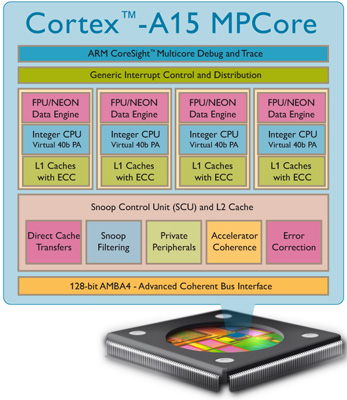
ARM's recently announced Cortex A15 should be able to outperform Intel's current generation Atom depending on clock speed/core count configurations. Add another generation beyond that and you might have the performance of a mainstream PC today, at least the lower end of the mainstream segment.
Tony further admitted that although it would be technically feasible for mainstream PC users to replace their PCs with smartphones in three years, there are a number of other things that will likely prevent such a thing from happening too quickly. But he was confident that within the next 10 years, mainstream PCs will be nothing more than smartphones tethered wirelessly to a monitor, keyboard and mouse. When you're done at your desk you'll just pick up your smartphone and carry it with you.
Note that this future only pertains to mainstream PCs (e.g. sub-$500 market). There's still an obvious benefit to having a larger chassis that can accommodate higher transistor counts and higher TDPs.
I've heard other PC companies offer similar visions of the future, although they all disagree on the timeframe. I've heard periods as short as 5 years and as long as 20 years. Predictions have a nasty habit of not taking the unpredictable future into consideration, but this is definitely a valid possibility for the next decade or so.
It wasn't a coincidence that we had this conversation at dinner some months ago. Tony knew what was being announced at CES.
Jen-Hsun Takes the Stage
Jen-Hsun's CES keynote was probably the best I'd seen him do in recent history. The last time I heard Jen-Hsun speak was at the first and only NVISION conference. His keynote at the time was about the importance of GPUs and the role they'll play in future computing devices. The keynote was bland. It ignored the obvious need for a a balance of good CPU *and* GPU technology. It was everything we've grown to despise about NVIDIA - Jen Hsun spoke about a world where GPUs and NVIDIA were driving the entire computing industry forward. He spoke about a world that didn't exist.
Jen-Hsun at CES 2011 was more like the old Jen-Hsun. There was more passion, more belief, less BS. But he was also a more mature Jen-Hsun. He still took his jabs at x86 and the Wintel alliance, but he offered better perspective - not just an injection of whatever NVIDIA cooked up in the basement the other night.
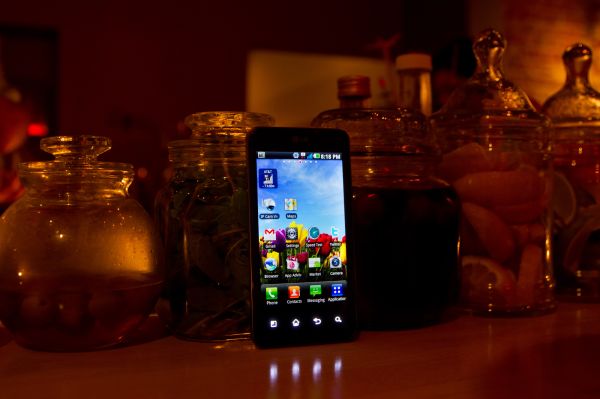
LG's Optimus 2X - The first Tegra 2 smartphone
At CES 2011 NVIDIA finally announced the first smartphone based on its Tegra 2 SoC: LG's Optimus 2X. Motorola followed up with three more Tegra 2 based devices. And although Google didn't make a big deal out of it at the show, NVIDIA also has the honor of being the official SoC partner on the Honeycomb release of Android. The first OEMs to launch Honeycomb tablets will be running NVIDIA Tegra 2 SoCs.
NVIDIA also announced its intentions to plug the gaping hole in its future. The company is an ARM architecture licensee, and Project Denver will be its first high performance CPU design.
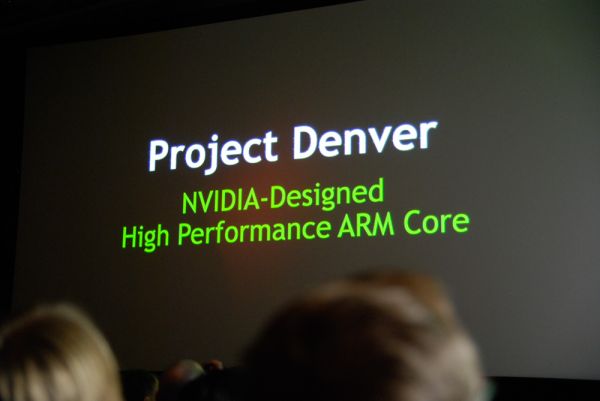
If high end smartphones will begin to replace mainstream PCs, NVIDIA needs to offer a compelling CPU, GPU and overall SoC for that market. Jen-Hsun always understood the importance of the OEMs in gaining traction in the PC market, and OEMs tend to want to have the best hardware possible. In order to give them that, NVIDIA can't simply ship an off-the-shelf ARM core, it needs something better than that.
So what's the point of all of this?
If smartphones are moving up in the world and will eventually be powerful enough to drive a high resolution display and run mainstream computing tasks, the evolution has to start now. There are usually a bunch of failed attempts and baby steps before we finally arrive at the product that just clicks. Look no further than the smartphone market for proof of that. It took years of PDAs and crap phones before we got to things like the Droid, the iPhone and the Palm Pre.
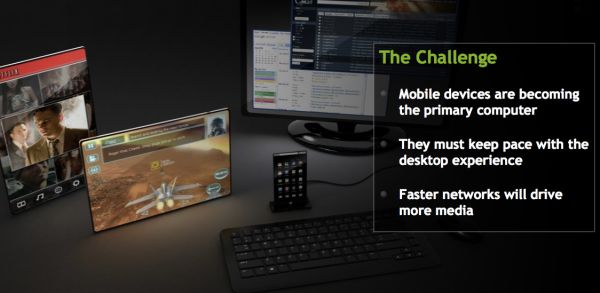
The battle for the advancement of smartphones has begun, and Motorola just fired the first shot.
LG announced and began shipping the world's first Tegra 2 based smartphone, however it looks and behaves much like any other Android phone - just faster.
Motorola's flagship Tegra 2 device is a little different. At CES Motorola announced the Atrix 4G as a dual-core superphone with 1GB of RAM and a 1930mah battery. I was worried that this meant the Tegra 2 couldn't be trusted on a battery, but LG proved me wrong. The point of the extra large battery and the ridiculous memory capacity is because Motorola wants the Atrix 4G to be more than just a smartphone. It wants it to compete with a netbook.
Don't get me wrong. What Motorola wants and the reality that exists don't exactly line up. A netbook will still give you a better computing experience, particularly something based on AMD's latest Brazos platform. But as I mentioned earlier, a revolution has to start somewhere.
A couple of days ago I got a package from Motorola. In it was the Atrix 4G, a multimedia dock, bluetooth keyboard and mouse. I'm currently on a flight to Barcelona to join Brian Klug as we cover Mobile World Congress for the first time on AnandTech. MWC is a very large mobility focused tradeshow that's held yearly. From a content standpoint it's like a smartphone/tablet CES.
It takes days for us to run through all of our battery life tests, and usually a couple of weeks of constant usage for us to put together one of our smartphone reviews. With Brian working on the Verizon iPhone 4 and both of us en route to MWC, it'll be a little while before we can bring you a full, in-depth Atrix 4G review.
That being said I wanted to get some of my thoughts out there as this is a highly anticipated device that attempts to do a lot.
What follows is by no means a full review, I wouldn't dream of calling it that. But rather an account of my experiences with Motorola's Atrix 4G thus far. Give me some time after MWC and we'll get a full review up. The Atrix hasn't left my side since it arrived and I'll be using it to keep up with emails and schedule meetings at the show as well. Be sure to read our Optimus 2X Review for more coverage on what makes up NVIDIA's Tegra 2 SoC.


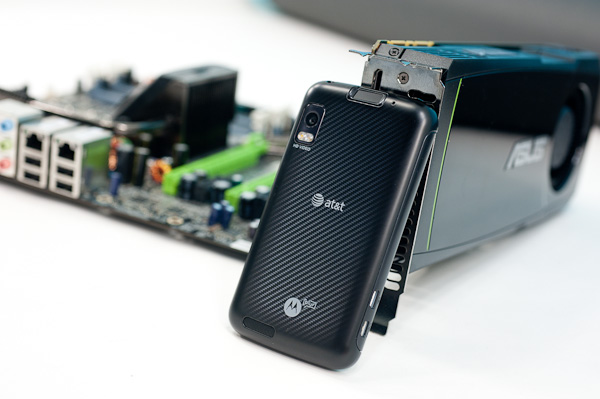
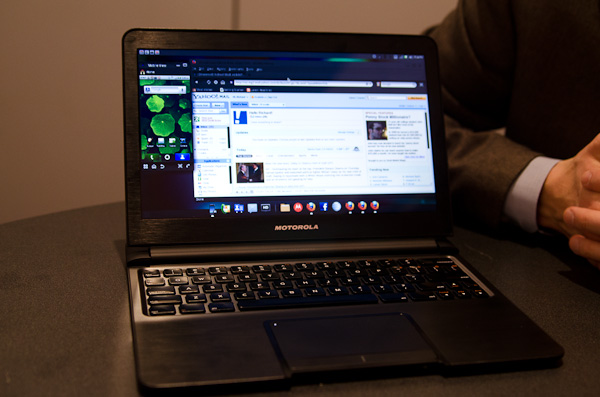
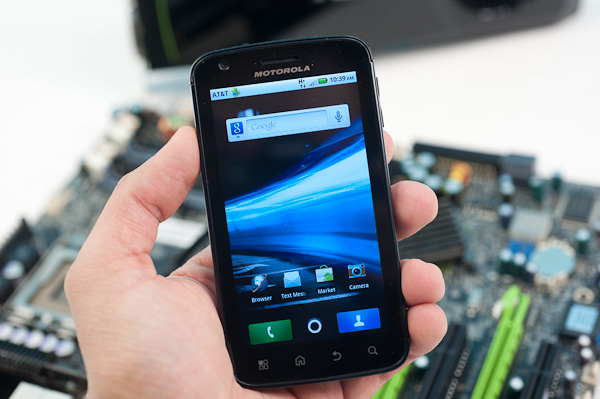








41 Comments
View All Comments
jigglywiggly - Sunday, February 13, 2011 - link
i spy with my little eyes a 780i motherboard.EvlG - Sunday, February 13, 2011 - link
Nice writeup! Can you send a SMS from the portal? Or just view/delete? Would be convenient to be able to chat over SMS without having to get the phone out of my pocketCallumS - Sunday, February 13, 2011 - link
Hi AnandJust noticed that you mentioned two different resolutions;
In the text: "On the front is the 4.0" qHD PenTile LCD screen (960 x 540 resolution)"
In the table:4" IPS-LCD 800x480
Can you please confirm/fix? I hope the first one is correct!
Cheers
Callum
Chloiber - Sunday, February 13, 2011 - link
There is a whole page about the screen...CallumS - Sunday, February 13, 2011 - link
Yeah sorry I noticed that later. Obviously just the table is wrong.Looking forward to this and other mobile's with high resolution displays!
StormyParis - Sunday, February 13, 2011 - link
It does seem to make sense to move phones towards the desktop. They are, or will soon be, powerful enough for most uses. However- the price is outrageous. I can get a very good netbook or even laptop for less money
- the whole setup is proprietary. With the accelerated mobile phone upgrade cycle, it means it's money down a very fast drain. A netbook/laptop will be easier to re-use.
HP's tap to synch approach makes a lot more sense until these two issues are solved, if they ever are.
Leimi - Sunday, February 13, 2011 - link
Hi,Thanks for this great preview, this phone seems to be a really great device :)
One question though, do you know if the LED is multi color ? You can test this with Blink (you have to switch off screen after choosing a color). It's on the market : https://market.android.com/details?id=imoblife.bli...
Thanks
jcompagner - Sunday, February 13, 2011 - link
My carrier has no influence on what phone or what software is on that phone at all. I never buy my phone through my carrier, always just on 1 of the many gsm webshops there are over here.Most of the time i just buy my phone when ever a phone comes around that i want to have, i don't look at my contract at all (i also could do that but i most of the time don't do that)
So buy my phone for 600 euro.. then i go to my carrier when my contract ends (when ever that is) and then i ask them what the best sim only contract there is what they can offer me.. (1 or 2 years). Currently the 2 year was the best so what i get was a 25 euro contract per month where i get 40% off over 2 years, and the first 6 months i did get an additional 50% off on top over that.
So that's the first 6 months 17.5 euro off (105 euro) and then 18 months 10 euro off (180) thats in total 285 euro that i save, so that i only payed for my high end phone 315 euro on a contract of 25 euro.. And i can buy whenever i want a new phone and extend my contract when thats around the corner.. they are not related to each other.
erwos - Sunday, February 13, 2011 - link
They apparently want $500 for the laptop dock and $130 for the desktop dock, not to mention tethering charges WHEN YOU ARE NOT TETHERING.It's completely absurd, and is probably the first time I've actually started wishing for carrier subsidies to be outlawed, as they are in some countries.
svengalis - Sunday, February 13, 2011 - link
Nope it can't mirror. This is why the Optimus 2x is better to me. It does TRUE mirroring of the WHOLE UI so no need for this silly laptop dock when I can buy a cheap laptop and do basically the same thing for FREE.